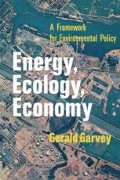Abstract
Reckoning the externalized cost of depletive waste in energetic terms underscores the fact that patterns of energy flow—even over millions of years, and even under extreme human interference with nature’s pace of change—follow definite physical laws. A consideration of these ecological and thermodynamic laws will introduce an analysis of energy costs under two remaining categories of environmental externality: “seral disturbance” and “pollutive build-up.”
The balance of nature is not the same today as in Pleistocene times, but it is still there: a complex, precise, and highly integrated system of relationships between living things.… Man, too, is part of this balance. Sometimes the balance is in his favor; sometimes—and all too often through his own activities—it is shifted to his disadvantage.
Rachel Carson, Silent Spring
Preview
Unable to display preview. Download preview PDF.
References
The chapter epigraph comes from p. 6 of the Carson book (1962), as does, indeed, much of the sympathy for an “ecological perspective” expressed in this chapter. Also used were Edward Kormondy, Concepts of Ecology (1969), esp. Ch. 2 and 5; National Academy of Science-National Research Council Report 1400, Waste Management and Control (1966); and Lamont Cole, “The Ecosphere,” April 1958 Scientific American. The related “quasi-consumption” concept is based on a seminal paper by Robert Ayres and Allen Kneese in the July 1969 American Economic Review.
Statistics used in the agricultural pollution example on p. 65 come from Richard Wagner, Environment and Man (1971), pp. 11415 and Barry Commoner, The Closing Circle (1971), pp. 149–150.
The Spilhaus quote on p. 70 comes from the March 1970 Science p. 1673.
No reference section on systematic ecology is complete without an avowal of intellectual debt to the Odums, Eugene and Howard. As indicated at p. 64, the basic “energy budget” and “energy balance” approach traces to work by Eugene P. Odum. See especially his Ecology (1966) and Howard T. Odum’s Environment, Power and Society (1971). An energy balance computation relevant to the theme of this chapter appears in the Odums’ “Natural Areas as Necessary Components of Man’s Total Environment,” in 1972 Transactions of the North America Wildlife Conference furnished in pre-publication draft by the authors.
Supplementing the Odum framework and illustrating energy flow concepts for other types of ecosystems are Clifford Geertz, “Two Types of Ecosystems,” Dwain Parrack, “The Bioenergetics of Rural West Bengal,” and Richard Lee, “Kung Bushmen Subsistence: An Input-Output Analysis,” all in A. P. Vayda, ed., Environmental and Cultural Behavior (1969).
Author information
Authors and Affiliations
Copyright information
© 1972 W. W. Norton & Company Inc.
About this chapter
Cite this chapter
Garvey, G. (1972). Energy and Ecology. In: Energy, Ecology, Economy. Palgrave, London. https://doi.org/10.1007/978-1-349-02421-6_3
Download citation
DOI: https://doi.org/10.1007/978-1-349-02421-6_3
Publisher Name: Palgrave, London
Print ISBN: 978-0-333-17480-7
Online ISBN: 978-1-349-02421-6
eBook Packages: Palgrave Economics & Finance CollectionEconomics and Finance (R0)

